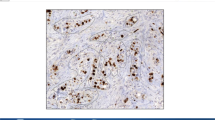Summary
Certain types of benign breast disease (BBD) carry an increased risk of malignancy. Several morphological criteria such as an atypia score are used to define this group, and the use of a kinetic parameter may provide additional information. Therefore, the growth fractions of 120 benign breast lesions were determined using the monoclonal antibody Ki-67. The values obtained range from 0.3% to 10.8% (average 3.1%±2.2%) compared to breast carcinomas with an average of 15.3%±10.1%, range 0.8% to 47.8%. All specimens were classified using the terminology of Azzopardi. The prevailing histological entities were cystic disease, fibroadenoma, and blunt duct adenosis. Between these groups no differences in growth fractions were observed. Postmenopausal patients had slightly lower values than premenopausal women. Further prospective studies are need to evaluate whether those cases of BBD with a high number of Ki-67 positive cells have an increased risk of breast cancer, independently from conventional histological classifications.
Similar content being viewed by others
References
Azzopardi JG (1979) Problems in breast pathology. In: Bennington JL (ed) Major problems in pathology, vol 11. Saunders, London Philadelphia Toronto, pp 23–28
Black MM, Barclay THC, Cutler SJ, Hankey BF, Asire AJ (1972) Association of atypical characteristics of benign breast lesions with subsequent risk of breast cancer. Cancer 29:338–343
Deschenes L, Jacob S, Fabia J, Christen A (1985) Beware of breast fibroadenomas in middle-aged women. Can J Surg 28:372–374
Dixon JM, Lumsden AB, Miller WR (1985) The relationship of cyst type to risk factors for breast cancer and the subsequent development of breast cancer in patients with breast cystic disease. Eur J Cancer Clin Oncol 21:1047–1050
Dupont WD, Page DL (1985) Risk factors for breast cancer in women with proliferative breast disease. N Engl J Med 312:146–151
Ernster VL (1981) The epidemiology of benign breast disease. Epidemiol Rev 3:184–202
Fondo EY, Rosen PP, Fracchia AA, Urban JA (1979) The problem of carcinoma developing in a fibroadenoma. Cancer 43:563–567
Gerdes J, Schwab U, Lemke H, Stein H (1983) Production of a mouse monoclonal antibody reactive with a human nuclear antigen associated with cell proliferation. Int J Cancer 31:13–20
Gerdes J, Lemke H, Baisch H, Wacker HH, Schwab U, Stein H (1984) Cell cycle analysis of a cell proliferation-associated human nuclear antigen defined by the monoclonal antibody Ki-67. J Immunol 133:1710–1715
Gerdes J, Lellé RJ, Pickartz H, Heidenreich W, Schwarting R, Stauch G, Stein H (1986) Growth fractions in human breast cancer as determined in situ with monoclonal antibody Ki-67. J Clin Pathol 39:977–980
Gudim-Levkovich KA, Yakhimovich LV, Slinchak SM, Kaminskaya LP, Kovbasyuk SA, Polozun LV, Umanskii YA (1981) Proliferative activity of cells in dyshormonal fibroadenomatosis of the human breast. Byulleten Eksperimental'nol Biologii i Meditsiny 92:601–603
Lellé RJ, Heidenreich W, Stauch G, Gerdes J (1986) Bestimmung der Wachstumsfraktion bei Mammakarzinomen mit Hilfe des monoklonalen Antikörpers Ki-67. Tumor Diagnostik & Therapie 7:181–185
Lellé RJ, Heidenreich W, Stauch G, Gerdes J (1987) Growth fractions as determined in situ with the monoclonal antibody Ki-67, histologic grading and lymph-node stage in human mammary carcinoma. Cancer (in press)
Meyer JS (1977) Cell proliferation in normal human breast ducts, fibroadenomas, and other ductal hyperplasias measured by nuclear labeling with tritiated thymidine. Hum Pathol 8:67–81
Meyer JS, Bauer WC (1976) Tritiated thymidine labeling index of benign and malignant human breast epithelium. J Surg Oncol 8:165–181
Meyer JS, Connor RE (1982) Cell proliferation in fibrocystic disease and postmenopausal breast ducts measurements by thymidine labeling. Cancer 50:746–751
Moran RE, Black MM, Alpert L, Straus MJ (1984) Correlation of cell-cycle kinetics, hormone receptors histopathology, and nodal status in human breast cancer. Cancer 54:1586–1590
Myhre E (1984) Is fibrocystic disease a pre-malignant state? Acta Obstet Gynecol Scand (Suppl) 123:189–191
Nomura A, Comstock GW, Tonascia JA (1977) Epidemiologic characteristics of benign breast disease. Am J Epidemiol 105:505–512
Prechtel K (1974) Allgemeine Erläuterungen zur Histomorphologie von Brustdrüsenerkrankungen. Fortschr Med 92:374–380
Prechtel K, Schmidt H (1979) Eine sechsjährige Verlaufsstudie bei Frauen mit bioptisch gesicherter Mastopathie. Verh Dtsch Ges Path 63:609–612
Russo J, Russo IH (1978) DNA labeling index and structure of the rat mammary gland as determinants of its susceptibility to carcinogenesis. J Natl Cancer Inst 61:1451–1459
Russo J, Russo IH (1980) Influence of differentiation and cell kinetics on the susceptibility of the rat mammary gland to carcinogenesis. Cancer Res 40:2677–2687
Russo J, Wilgus G, Russo IH (1979) Susceptibility of the mammary gland to carcinogenesis. I. Differentiation of the mammary gland as determinant of tumor incidence and type of lesion. Am J Pathol 96:721–736
Schiffer LM, Braunschweiger PG, Stragand JJ, Poulakos L (1979) The cell kinetics of human mammary cancers. Cancer 43:1707–1719
Tubiana M (1971) The kinetics of tumour cell proliferation and radiotherapy. Br J Radiol 44:325–347
Stein H, Gerdes J, Schwab U, Lemke H, Mason DY, Ziegler A, Schienle W, Diehl V (1982) Identification of Hodgkin and Sternberg-Reed cells as a unique cell type derived from a newly-detected small-cell population. Int J Cancer 30:445–459
SPSSX user's guide (1983) McGraw-Hill, New York
Wang DY, Fentiman IS (1985) Epidemiology and endocrinology of benign breast disease. Breast Cancer Res Treat 6:5–36
Author information
Authors and Affiliations
Rights and permissions
About this article
Cite this article
Lellé, R.J., Heidenreich, W., Stauch, G. et al. Determination of growth fractions in benign breast disease (BBD) with monoclonal antibody Ki-67. J Cancer Res Clin Oncol 113, 73–77 (1987). https://doi.org/10.1007/BF00389970
Received:
Accepted:
Issue Date:
DOI: https://doi.org/10.1007/BF00389970




